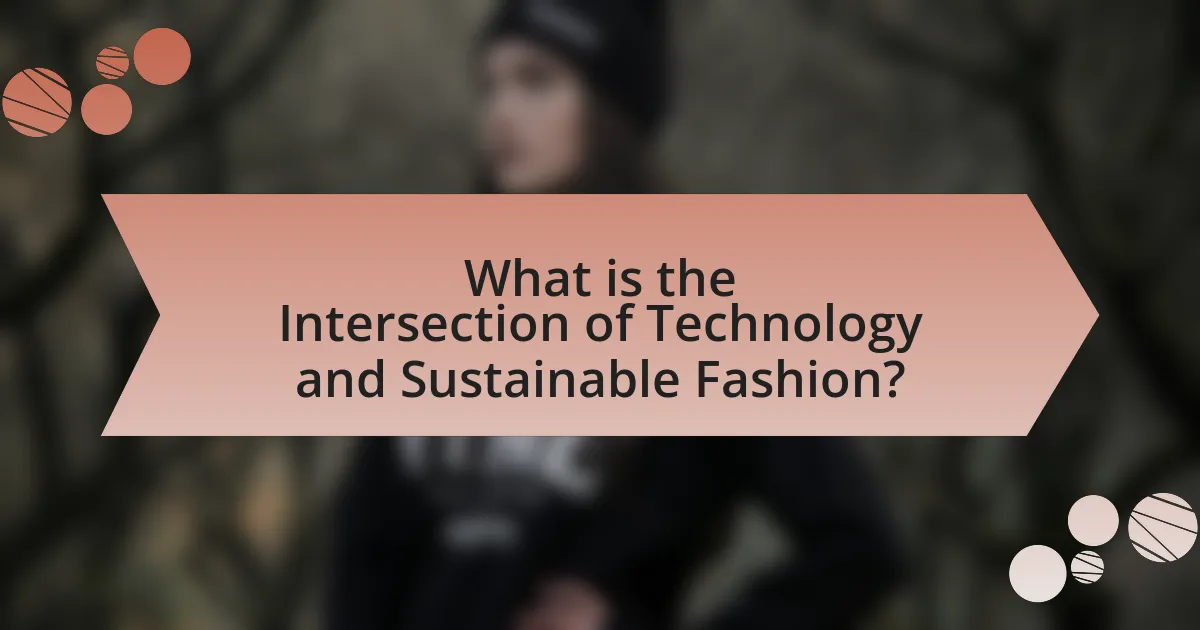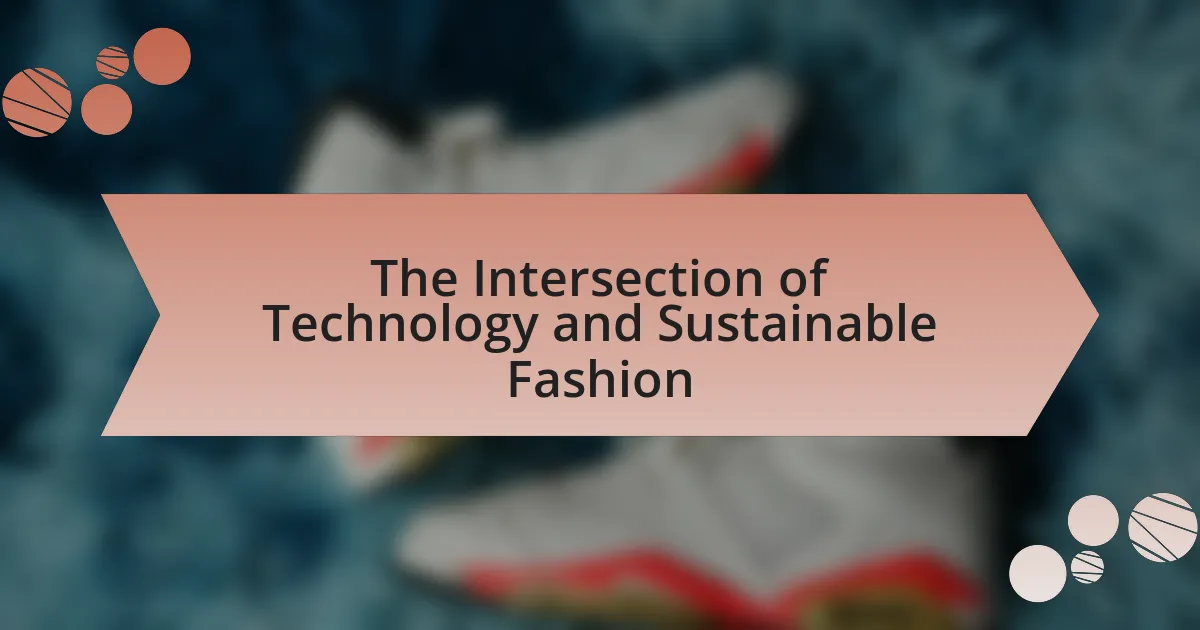The article explores the intersection of technology and sustainable fashion, highlighting how innovative technologies such as artificial intelligence, blockchain, and 3D printing are transforming the fashion industry towards greater environmental sustainability. It discusses the relationship between technology and sustainable practices, detailing advancements in materials, production processes, and supply chain management that reduce waste and enhance resource efficiency. Key technologies shaping sustainable fashion are examined, along with their impact on supply chain optimization, consumer engagement, and waste reduction. The article also addresses the challenges brands face in integrating technology with sustainability and offers strategies for effective implementation, emphasizing the role of consumer engagement in supporting sustainable fashion initiatives.

What is the Intersection of Technology and Sustainable Fashion?
The intersection of technology and sustainable fashion involves the integration of innovative technologies to enhance environmental sustainability within the fashion industry. Technologies such as artificial intelligence, blockchain, and 3D printing are being utilized to optimize supply chains, reduce waste, and promote transparency in sourcing materials. For instance, AI algorithms can analyze consumer behavior to minimize overproduction, while blockchain technology ensures traceability of materials, confirming ethical sourcing practices. According to a report by McKinsey & Company, the adoption of these technologies can significantly reduce the carbon footprint of fashion brands, aligning with global sustainability goals.
How do technology and sustainable fashion relate to each other?
Technology and sustainable fashion are interconnected through innovations that enhance eco-friendly practices in the fashion industry. For instance, advancements in materials science have led to the development of biodegradable fabrics and recycled textiles, reducing waste and environmental impact. Additionally, technologies like 3D printing and digital design minimize resource consumption and allow for on-demand production, which decreases overproduction and excess inventory. According to a report by McKinsey & Company, the integration of technology in fashion can potentially reduce greenhouse gas emissions by 30% by 2030, highlighting the significant role technology plays in promoting sustainability within the industry.
What technological advancements are influencing sustainable fashion?
Technological advancements influencing sustainable fashion include innovations in materials, production processes, and supply chain management. For instance, the development of biodegradable fabrics, such as those made from organic cotton or recycled polyester, reduces environmental impact. Additionally, 3D printing technology allows for on-demand production, minimizing waste associated with overproduction. Furthermore, blockchain technology enhances transparency in supply chains, enabling consumers to verify the sustainability of their purchases. According to a report by McKinsey & Company, these technologies can significantly reduce the carbon footprint of the fashion industry, which is responsible for approximately 10% of global greenhouse gas emissions.
How does sustainable fashion benefit from technological integration?
Sustainable fashion benefits from technological integration by enhancing resource efficiency and reducing waste throughout the production process. Technologies such as 3D printing and digital pattern-making allow for precise material usage, minimizing excess fabric and lowering environmental impact. For instance, a study by the Ellen MacArthur Foundation highlights that adopting digital technologies can reduce material waste by up to 90% in some cases. Additionally, blockchain technology improves supply chain transparency, enabling consumers to verify the sustainability of their purchases, which fosters ethical consumption. This integration of technology not only streamlines operations but also promotes a circular economy, where materials are reused and recycled, further supporting sustainability goals.
Why is the intersection of technology and sustainable fashion important?
The intersection of technology and sustainable fashion is important because it enables innovative solutions that reduce environmental impact and enhance resource efficiency. Technology facilitates the development of sustainable materials, such as bio-fabricated textiles and recycled fibers, which significantly lower carbon emissions and waste associated with traditional fashion production. For instance, the use of 3D printing in fashion allows for on-demand production, minimizing overproduction and excess inventory, which are major contributors to waste in the industry. Additionally, data analytics and blockchain technology improve supply chain transparency, enabling consumers to make informed choices and promoting ethical practices. These advancements collectively contribute to a more sustainable fashion ecosystem, addressing the urgent need for environmental responsibility in the industry.
What environmental challenges does sustainable fashion address?
Sustainable fashion addresses several environmental challenges, including excessive waste, resource depletion, and pollution. The fashion industry is responsible for producing 92 million tons of waste annually, with a significant portion coming from fast fashion practices that encourage overconsumption and disposal. Additionally, sustainable fashion promotes the use of eco-friendly materials and production methods, which help reduce the depletion of natural resources such as water and fossil fuels. For instance, conventional cotton farming consumes approximately 7,000 liters of water per kilogram of cotton produced, while sustainable practices aim to minimize water usage and chemical runoff. Furthermore, sustainable fashion seeks to mitigate pollution by advocating for cleaner production processes and reducing carbon emissions associated with textile manufacturing and transportation.
How can technology help mitigate these challenges?
Technology can help mitigate challenges in sustainable fashion by enabling efficient resource management and reducing waste through innovative practices. For instance, digital tools like 3D modeling and virtual fitting rooms minimize the need for physical samples, thereby decreasing material waste. Additionally, blockchain technology enhances transparency in supply chains, allowing consumers to verify the sustainability of products, which can drive demand for eco-friendly practices. According to a report by McKinsey & Company, implementing digital technologies in fashion can lead to a 30% reduction in waste and a 20% increase in efficiency, demonstrating the tangible benefits of technology in addressing sustainability challenges.

What are the key technologies shaping sustainable fashion?
Key technologies shaping sustainable fashion include digital textile printing, blockchain, and artificial intelligence. Digital textile printing reduces waste by allowing for on-demand production, minimizing excess inventory and resource use. Blockchain enhances transparency in supply chains, enabling consumers to verify the sustainability of materials and practices. Artificial intelligence optimizes design processes and inventory management, leading to more efficient resource allocation and reduced environmental impact. These technologies collectively contribute to a more sustainable fashion industry by promoting efficiency, transparency, and responsible consumption.
How is artificial intelligence used in sustainable fashion?
Artificial intelligence is used in sustainable fashion primarily to optimize supply chains, reduce waste, and enhance design processes. By analyzing data on consumer preferences and trends, AI algorithms can predict demand more accurately, allowing brands to produce only what is needed, thereby minimizing overproduction and waste. For instance, companies like H&M utilize AI to analyze customer data and optimize inventory management, which has been shown to reduce excess stock by up to 30%. Additionally, AI-driven tools can assist in creating sustainable materials by simulating the properties of fabrics, leading to innovations in eco-friendly textiles. This integration of AI not only supports sustainability goals but also drives efficiency in the fashion industry.
What role does AI play in supply chain optimization?
AI plays a crucial role in supply chain optimization by enhancing efficiency, reducing costs, and improving decision-making processes. Through predictive analytics, AI analyzes vast amounts of data to forecast demand accurately, enabling companies to adjust inventory levels and reduce waste. For instance, a study by McKinsey & Company found that companies using AI in their supply chains can reduce forecasting errors by 50%, leading to significant cost savings and improved service levels. Additionally, AI-driven automation streamlines logistics and inventory management, further optimizing operations and contributing to sustainability in the fashion industry.
How can AI enhance consumer engagement in sustainable practices?
AI can enhance consumer engagement in sustainable practices by providing personalized recommendations and insights that align with individual values and preferences. For instance, AI algorithms analyze consumer behavior and preferences to suggest sustainable products, thereby increasing awareness and encouraging eco-friendly purchasing decisions. Research from McKinsey & Company indicates that personalized marketing can lead to a 20% increase in engagement rates, demonstrating the effectiveness of tailored approaches in promoting sustainability. Additionally, AI-driven platforms can facilitate transparency in supply chains, allowing consumers to track the sustainability of their purchases, which further fosters trust and engagement in sustainable practices.
What impact does 3D printing have on sustainable fashion?
3D printing significantly impacts sustainable fashion by enabling on-demand production, which reduces waste and overproduction. Traditional fashion manufacturing often leads to excess inventory and material waste, whereas 3D printing allows designers to create items only as needed, minimizing surplus. According to a study by the Ellen MacArthur Foundation, the fashion industry generates 92 million tons of waste annually, and on-demand production through technologies like 3D printing can help mitigate this issue by producing only what is necessary. Additionally, 3D printing can utilize sustainable materials, such as biodegradable plastics, further enhancing its eco-friendly potential in the fashion sector.
How does 3D printing reduce waste in the fashion industry?
3D printing reduces waste in the fashion industry by enabling on-demand production, which minimizes excess inventory and material waste. Traditional manufacturing often results in overproduction and leftover materials, whereas 3D printing allows designers to create items only as needed, significantly lowering the amount of unsold stock. According to a study by the Ellen MacArthur Foundation, the fashion industry generates 92 million tons of waste annually, much of which can be mitigated through technologies like 3D printing that promote a more efficient use of resources.
What are the limitations of 3D printing in sustainable fashion?
The limitations of 3D printing in sustainable fashion include high energy consumption, material constraints, and scalability challenges. High energy consumption is a significant concern, as the printing process often requires substantial electricity, which can negate sustainability benefits if sourced from non-renewable energy. Material constraints arise because many 3D printing materials, such as certain plastics, are not biodegradable and can contribute to environmental waste. Scalability challenges exist because while 3D printing allows for customization and reduced waste in small batches, it is not yet efficient for mass production, which limits its application in the broader fashion industry. These factors collectively hinder the potential of 3D printing to fully align with sustainable fashion goals.

How can brands effectively implement technology for sustainability?
Brands can effectively implement technology for sustainability by integrating data analytics, automation, and innovative materials into their operations. Data analytics enables brands to assess their supply chain efficiency and identify areas for waste reduction, leading to more sustainable practices. Automation can streamline production processes, minimizing resource consumption and energy use. Additionally, the use of innovative materials, such as biodegradable fabrics or recycled materials, can significantly reduce environmental impact. For instance, a study by McKinsey & Company found that adopting sustainable materials could reduce greenhouse gas emissions in the fashion industry by up to 30%. This evidence supports the effectiveness of technology in promoting sustainability within the fashion sector.
What strategies can fashion brands adopt to integrate technology?
Fashion brands can adopt several strategies to integrate technology, including utilizing data analytics for consumer insights, implementing augmented reality for virtual try-ons, and leveraging blockchain for supply chain transparency. Data analytics allows brands to understand consumer preferences and trends, enhancing product development and marketing strategies. Augmented reality technology enables customers to visualize how clothing will look on them without physical trials, improving the shopping experience. Blockchain technology provides a secure and transparent method to track the origin and journey of materials, promoting sustainability and ethical practices in the fashion industry. These strategies not only enhance operational efficiency but also align with the growing consumer demand for transparency and sustainability in fashion.
How can brands leverage data analytics for sustainable practices?
Brands can leverage data analytics for sustainable practices by utilizing insights from consumer behavior, supply chain efficiency, and resource management. By analyzing data on customer preferences and purchasing patterns, brands can optimize inventory levels, reducing waste and overproduction. For instance, a study by McKinsey & Company found that data-driven supply chain management can lead to a 20-30% reduction in waste. Additionally, brands can track their carbon footprint and resource usage through data analytics, enabling them to make informed decisions that align with sustainability goals. This approach not only enhances operational efficiency but also fosters transparency and accountability in sustainable practices.
What partnerships can enhance technological innovation in sustainable fashion?
Collaborations between fashion brands, technology companies, and research institutions can significantly enhance technological innovation in sustainable fashion. For instance, partnerships with tech firms specializing in materials science can lead to the development of eco-friendly fabrics that reduce environmental impact. Research institutions can provide valuable insights into sustainable practices and innovative production techniques, while fashion brands can implement these advancements into their supply chains. A notable example is the collaboration between Adidas and Parley for the Oceans, which focuses on creating footwear from recycled ocean plastic, demonstrating how cross-sector partnerships can drive sustainable innovation in the fashion industry.
What challenges do brands face in merging technology with sustainability?
Brands face significant challenges in merging technology with sustainability, primarily due to high costs, lack of expertise, and consumer skepticism. The integration of advanced technologies, such as blockchain for supply chain transparency or AI for optimizing resource use, often requires substantial financial investment, which can be a barrier for many companies. Additionally, the rapid pace of technological advancement means that brands may struggle to find skilled professionals who can effectively implement and manage these sustainable technologies. Consumer skepticism also poses a challenge, as many customers question the authenticity of sustainability claims, leading brands to invest further in transparent practices and certifications to build trust. These factors collectively hinder the seamless integration of technology and sustainability in the fashion industry.
How can brands overcome resistance to technological change?
Brands can overcome resistance to technological change by fostering a culture of innovation and providing comprehensive training for employees. This approach encourages acceptance and adaptation to new technologies, as employees feel equipped and supported in their transition. Research indicates that organizations that invest in employee training see a 24% increase in productivity and a 20% increase in employee satisfaction, which directly correlates with a smoother implementation of technological advancements. By actively involving employees in the change process and demonstrating the benefits of technology, brands can effectively mitigate resistance and enhance overall performance in the context of sustainable fashion.
What are the financial implications of adopting new technologies?
Adopting new technologies in sustainable fashion can lead to significant financial implications, including both initial investment costs and long-term savings. For instance, implementing automated production processes may require substantial upfront capital but can reduce labor costs and increase efficiency over time. A study by McKinsey & Company found that companies investing in digital technologies can achieve up to a 20% reduction in operational costs. Additionally, new technologies can enhance product quality and reduce waste, leading to lower material costs and improved profit margins. Therefore, while the initial financial outlay may be high, the potential for cost savings and increased profitability makes the adoption of new technologies a financially sound decision in the long run.
What are best practices for consumers to support sustainable fashion through technology?
Consumers can support sustainable fashion through technology by utilizing apps and platforms that promote ethical brands, track clothing lifecycle, and facilitate second-hand purchases. For instance, apps like Good On You provide ratings for brands based on their sustainability practices, helping consumers make informed choices. Additionally, platforms such as Depop and Poshmark enable users to buy and sell second-hand clothing, reducing waste and extending the lifecycle of garments. Research indicates that the second-hand market is projected to grow to $64 billion by 2024, highlighting a shift towards more sustainable consumption patterns. By leveraging these technologies, consumers can actively contribute to a more sustainable fashion industry.
How can consumers utilize technology to make informed purchasing decisions?
Consumers can utilize technology to make informed purchasing decisions by leveraging online platforms, mobile applications, and data analytics tools that provide product information, reviews, and sustainability ratings. For instance, apps like Good On You evaluate fashion brands based on their environmental and ethical practices, allowing consumers to compare options before buying. Additionally, websites such as Consumer Reports offer detailed product reviews and comparisons, helping consumers assess quality and value. Research indicates that 79% of consumers prefer to shop with brands that are transparent about their sourcing and production processes, highlighting the importance of technology in facilitating informed choices.
What tools are available for consumers to track sustainable fashion brands?
Consumers can track sustainable fashion brands using various tools such as apps, websites, and databases specifically designed for this purpose. Notable examples include the Good On You app, which rates brands based on their sustainability practices, and the Ethical Consumer website, which provides detailed reports on companies’ ethical standards. Additionally, platforms like Fashion Revolution’s Fashion Transparency Index offer insights into brand transparency regarding their supply chains and sustainability efforts. These tools enable consumers to make informed choices by providing accessible information on the sustainability credentials of fashion brands.
